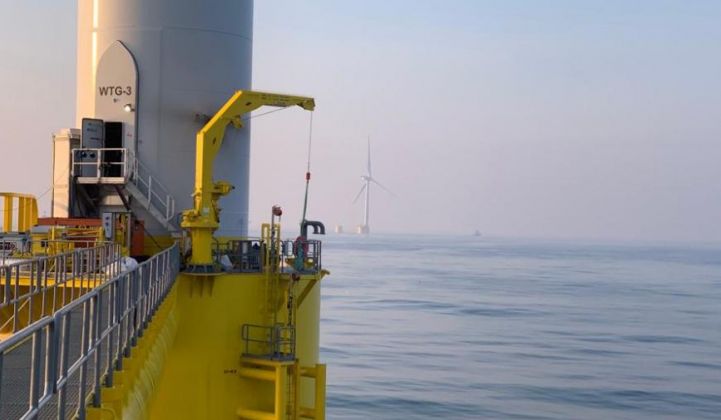The world’s largest floating wind turbine has begun generating power off the coast of Portugal.
The WindFloat Atlantic project connected the first of three 8.4-megawatt MHI Vestas turbines planned for installation. The second turbine is on site for connection.
WindFloat Atlantic is being developed by the Windplus consortium, comprising Portuguese utility EDP Renewables with a 54.4 percent stake, French energy giant Engie with 25 percent, Spanish oil major Repsol with 19.4 percent, and Principle Power, the developer of the floating platform itself, with a 1.2 percent interest.
The project is connected to a substation in Portugal via a 12-mile cable and secured with chains to the seabed 100 meters below. That sort of depth is outside the comfort zone of fixed bottom offshore wind, and it is that capability that lies at the root of floating wind’s advantages.
Deploying in deeper waters opens up new seabed areas for leasing and increases the potential total capacity for installations. What's more, by unleashing turbines farther from the shore, it could also see projects become more efficient as wind resources improve. It also sidesteps the challenges offshore wind has faced with regard to its visual impact of turbines visible on the horizon in promising markets like France.
For some markets lacking available shallow waters, like California or Japan, floating foundations could be the difference between unlocking a viable, scalable offshore market and or failing to do so.
Floating offshore wind firsts
Norwegian oil firm Equinor has been at the vanguard of floating wind, installing the Hywind floating turbine in a fjord back in 2009.
The sector's first commercial project, if one still not fully at utility-scale, was opened in October 2017. The Hywind Scotland project off the coast of Aberdeen consists of five 6-megawatt turbines, with Equinor taking a 75 percent share and the UAE’s clean energy vehicle Masdar the other 25 percent. During its first winter in the water, it achieved a capacity factor of 65 percent, or nearly twice the average capacity factor of onshore wind farms in the U.S.
More recently Equinor signed off on the 88-megawatt Hywind Tampen project off Norway. While groundbreaking in its own right, Hywind Tampen will directly power operations at two of Equinor's remote oil fields in the North Sea rather than attempting to make an onshore grid connection.
In total there may be more than a dozen further floating offshore wind projects commissioned in Europe by 2022. Hywind Tampen is the largest currently planned, with the rest all under 50 megawatts.
In France and the U.K., where the bulk of the European activity is, the switch from floating pilots to full-scale tenders is on the horizon.
France is planning a trio of 250-megawatt tenders just for floating wind. The U.K. is expected to consult on an “innovation pot” that would essentially ring-fence some budget in its contracts for difference (CFD) program for floating wind and others.
The new government in London has committed to supporting the technology, and an approach that leverages the CFDs would be welcomed by the industry. With floating infrastructure so prevalent in the North Sea oil business, the interest from Equinor, Shell and Repsol should come as no surprise.
WindFloat Atlantic benefited from a €60 million loan from the European Investment Bank, which acts as a multilateral bank to advance projects aligned with the EU’s goals. The EIB's new mandate from Brussels is to become a "climate bank," with half its lending directly for climate projects and the other half operating on a “do no harm” climate policy, meaning it will drop all fossil-fuel investment.
***
Wood Mackenzie will host a webinar on 15 January 2020 on Europe's energy transition. To attend, register here.




